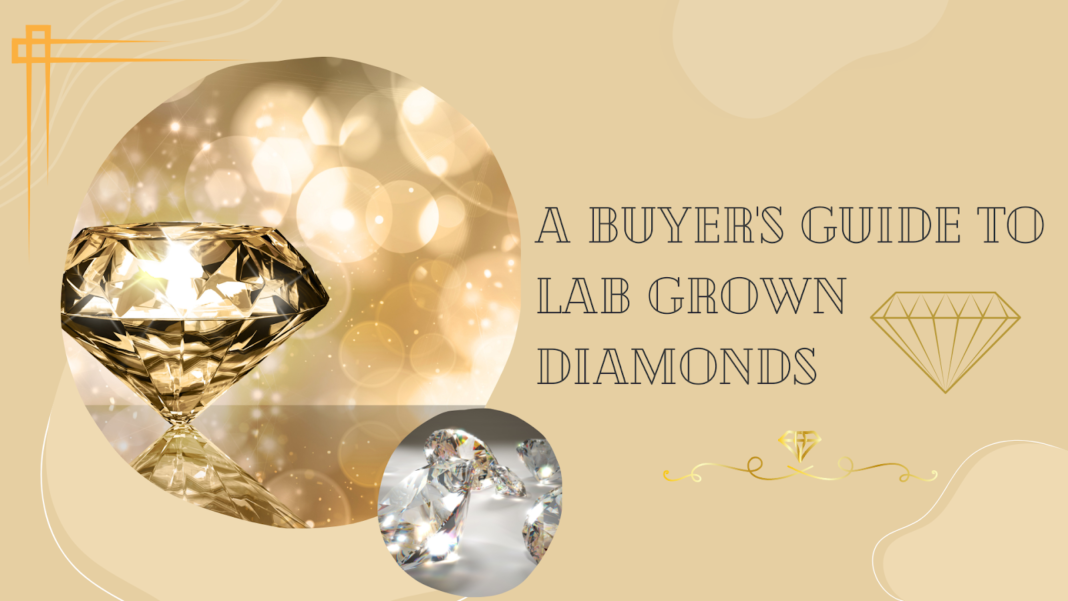The term synthetic diamonds or lab grown diamonds shouldn’t be new to you if you spend time in jewelry stores. Laboratory-grown diamonds have been around for decades and while they aren’t new, recent media exposure has increased awareness.
However, despite their sharp increase in popularity, there is a lot of debate around the sustainability claims of lab grown diamonds. This makes navigating the landscape of this new player in the diamond market an overwhelming task.
So, if you are considering buying a lab grown diamond engagement ring, tennis bracelet, band diamond cut, or piece of jewelry, you might be wondering what steps to take to ensure you get the perfect one.
Luckily, this article broadly discusses all you must know before purchasing lab grown or synthetic diamonds.
Let’s delve into detail!
First, What Are Lab Grown Diamonds?
In simple terms, lab grown diamonds are pure man-made carbon crystals. You can also refer to them as diamonds that are grown in a controlled laboratory environment, rather than in the wilds of the earth’s upper mantle.
Lab grown diamonds and naturally formed diamonds are similar because they are made of heated and highly-pressurized carbon. Furthermore, lab grown diamonds are produced with costly high-tech equipment using two different processes: High Temperature and High Pressure and Chemical Vapor Deposition.
This said, let’s discuss the benefits and downsides of lab grown diamonds.
Top 3 Benefits of Lab Grown Diamonds
- Affordability
Buying synthetic or lab grown diamonds means you can get a larger gem of higher quality than you would if you were shopping for a natural diamond. Lab grown diamonds can be up to 30% to 40% less than a natural diamond of similar color, clarity, and size.
- Eco-Friendliness
Although lab grown diamond production isn’t flawless, it’s inarguable that they have less of a negative impact on the earth and the people on it.
The production of lab grown diamonds doesn’t require mining. This doesn’t cause environmental degradation or put workers in dangerous or unsanitary conditions.
- Verified Origins
With various contention surrounding the locations of major diamond deposits, some consumers are wary about trusting natural diamonds at all.
Contrarily, you can be sure of a lab grown diamond, as you know its exact origin and the steps the brand takes to ensure sustainability and transparency.
Buying Lab Grown Diamonds
Below is a crucial step-by-step guide to choosing lab grown diamonds.
- Conduct In-Depth Research
First and most importantly, you need to have in-depth knowledge about the expected quality of the diamonds you want to purchase. Most lab grown diamonds are available for purchase on various websites, so you will want to be sure the company is reputable.
For instance, some companies use misleading information and sell diamond simulants. Additionally, they call these stimulants lab grown diamonds, which may be confusing to you.
- Size and Shape Availability
Although this hasn’t always been the case since lab grown diamonds are available in various sizes and shapes. However, certain shape and size combinations might be harder to come by.
For example, are you looking to purchase a diamond ring or a diamond pendant with a particular cut that’s difficult to come by? Then, you may need to be creative or choose a different cut set in a halo with a shape that achieves the overall look.
- Know the 4 C’s
Any guesses as to what the 4 C’s are all about? Whether you are buying a lab grown diamond or a natural diamond, the 4 C’s, color, cut, clarity, and carat weight, are crucial. The 4 C’s are what determines the diamond quality, and what significantly affects the cost.
However, while the 4 C’s are important, it is noteworthy that the grade is different for every diamond because each has its uniqueness.
Simultaneously, if budget is important, consider a lower clarity grade as most inclusions aren’t usually visible from the naked eye.
- Assess Jewelry Pattern
As stated in the second point, lab grown diamonds come in various shapes and sizes. However, it is essential to scrutinize the distinct jewelry designs of your jewelry pieces to ensure that they best suit and complement your personality.
- Focus on the Return Policies
To make your online lab grown diamond shopping experience secure and delightful, it is advisable to examine the return, exchange, and buyback policies carefully.
A trusted online store that values its customers ensures to provide customer-friendly policies spelling out the terms and conditions, in case of any future problems.
- Confirm Diamond Certification
Finally, before making a purchase, ensure you compare the separate gemstones and check the certificates of the various lab grown diamonds to confirm their authenticity.
You may select a GIA or IGI-certified lab grown diamond and settle for nothing less.
Final Thoughts on Lab Grown Diamonds
As stated in the introductory part of this article, lab grown diamonds are not a new term. In fact, they are increasingly gaining popularity.
With this guide, you can be sure to get the best lab-created diamond pendant, engagement rings, diamond stud earrings, tennis bracelets, and other captivating lab grown diamond jewelries to deck yourself up with extra bling for a sizzling style quotient.
Frequently Asked Questions About Lab Grown Diamonds
- Do Lab Grown Diamonds Glow in the Dark?
Yes, they do. Like natural or mined diamonds, lab grown diamonds can fluoresce under Ultraviolet light. This unique characteristic causes them to glow brighter shades of white or other colors.
- Can I Differentiate Between Lab Grown and Mined Diamonds Easily?
Yes, you can. To the naked eye, there are not many differences between lab grown and natural diamonds.
Additionally, lab grown diamonds have the same physical and chemical properties of natural diamonds. Also, they exhibit similar optical illusions as mined diamonds.
- Are Lab Grown Diamonds Cheaper Than Natural Diamonds?
Yes, most lab grown diamonds tend to retail at a 30% to 40% discount off of equivalent quality mined diamonds.
- What Does the IGI Diamond Certification Mean?
The IGI, also known as International Gemological Institute, is the world’s largest independent diamond grading lab.
IGI is one of the few labs that produce reports for lab grown diamonds whose gradings you can ascertain.
- Should I Be Bothered About the Diamond Type?
Yes, you should. Diamond type is a scientific classification that identifies the amount of impurities your diamond has. So yes, it is crucial to know the diamond type before making a purchase.















